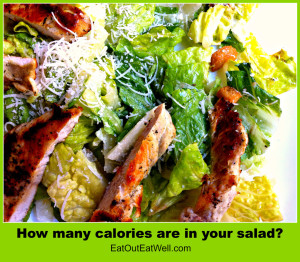So many of us think a salad, instead of a sandwich, is the way to go if we’re trying to be calorie conscious. Somehow we’ve embraced the idea that salads are always a light and healthy choice. Sometimes they are – but all too often they’re not.
Sometimes a sandwich is the clear winner in terms of calories and fat. A ham and cheese sandwich ranges from 350 to 450 calories depending upon how much ham and cheese there really is, the type of bread, and whether it comes with mustard or mayo (and, of course, without fries or chips).
And sometimes the salad is a better choice — depending on what goes into it. The nutrient rich plant foods that make the base of a salad are high in antioxidants — especially the dark green, orange, and red vegetables. Most of the vegetables are full of fiber – good for your cholesterol, your GI functioning, and as a way to feel fuller for a longer period of time. Salads take a long time to eat – much longer than sandwiches or pizza that you can scarf down far more quickly.
The Green Base For Salads
The green stuff that’s the base for most salads isn’t the problem. Most greens are very low in calories and pretty nutritious.
- 1 cup shredded Romaine: 8 calories, 1 gram fiber, 1 gram protein, 0 gram fat
- 1 cup of Arugula: 6 calories, 1 gram fiber, 1 gram protein, 0 gram fat
- 1 cup raw spinach: 7 calories, 1 gram of fiber, 1 gram protein
- 1 cup chopped kale: 32 calories, 1 gram of fiber, 2 grams of protein, 0 gram fat
Calorie Savers:
High calorie add-ins and dressings can make salads a “no thank you” choice.
- Generally, at least ¼ of a cup (frequently more) of dressing is added to a tossed salad. A ladle of creamy dressing has about 360 calories and 38g of fat (a cheeseburger worth). Vinaigrette dressing, usually 3 parts oil to one part vinegar, adds its own fat blast. For two tablespoons of dressing add:
- Blue cheese: 165 calories, 15g fat
- Italian: 160 calories, 15g fat
- French: 135 calories, 15g fat
- Low calorie Italian, 15 calories, 0g fat
- Oil and vinegar: 100 calories, 8g fat
- 1000 Island: 120 calories, 10g fat
- Vinegar: 4 calories, 0g fat
- Tuna, macaroni, egg, and chicken salads, the holy grail of delis and salad bars, are loaded with mayonnaise. On average (for a half cup – which is a pretty small serving):
- chicken salad has around 208 calories, 16g of fat
- tuna salad has 192 calories, 9g fat
- tuna pasta salad has 250 calories, 9g fat
- macaroni salad has 170 calories, 9g fat
- Croutons and Crispy Noodles:
- ¼ cup of plain croutons has 31 calories, 0g fat
- 1 serving of McDonald’s Butter Garlic Croutons has 60 calories
- 1g fat; ¼ cup of crispy noodles has 74 calories, 4g fat
- Dried cranberries: ¼ cup has 98 calories, 0g fat
- Then there’s cheese, for ¼ cup (which is really small):
- feta has 75 calories, 6g fat
- shredded cheddar has 114 calories, 9g fat
- blue cheese has 80 calories, 6g fat
- Beans, nuts and seeds:
- ¼ cup sunflower seeds: 210 calories, 19g fat
- chopped walnuts: 193 calories, 18g fat
- kidney beans, ¼ cup: 55 calories, trace fat
- chickpeas, ¼ cup: 40 calories, less than 1g fat
- Avocado, ¼ cup: 58 calories, 5g fat
- Bacon bits, 1 tablespoon: 25 calories, 2g fat
- Proteins:
- chopped egg, 2 tablespoons: 25 calories, 2g fat
- shrimp, 1 ounce: 30 calories, less than 1g fat
- water packed tuna, 1 ounce: 35 calories, less than 1g fat
- turkey, 1 ounce: 35 calories, less than 1g fat
- chopped ham, 1 ounce: 35 calories, 1g fat
- Bread (often used to sop up leftover dressing): 1 piece of French bread has 82 calories, 1g fat; 1 dinner roll, 78 calories, 2g fat. Dressing sopped up by the bread or roll: lots of extra fat calories!
Should Salads Go On Your “Do Not Touch” List?
Absolutely not. The healthy stuff in salad tastes great, fills you up, and is good for you. There are plenty of ways to cut down on the fatty and caloric add-ins and still end up with a really tasty salad. There are even good choices in fast food and chain restaurants (and plenty of really, really bad ones).


Leave a Reply